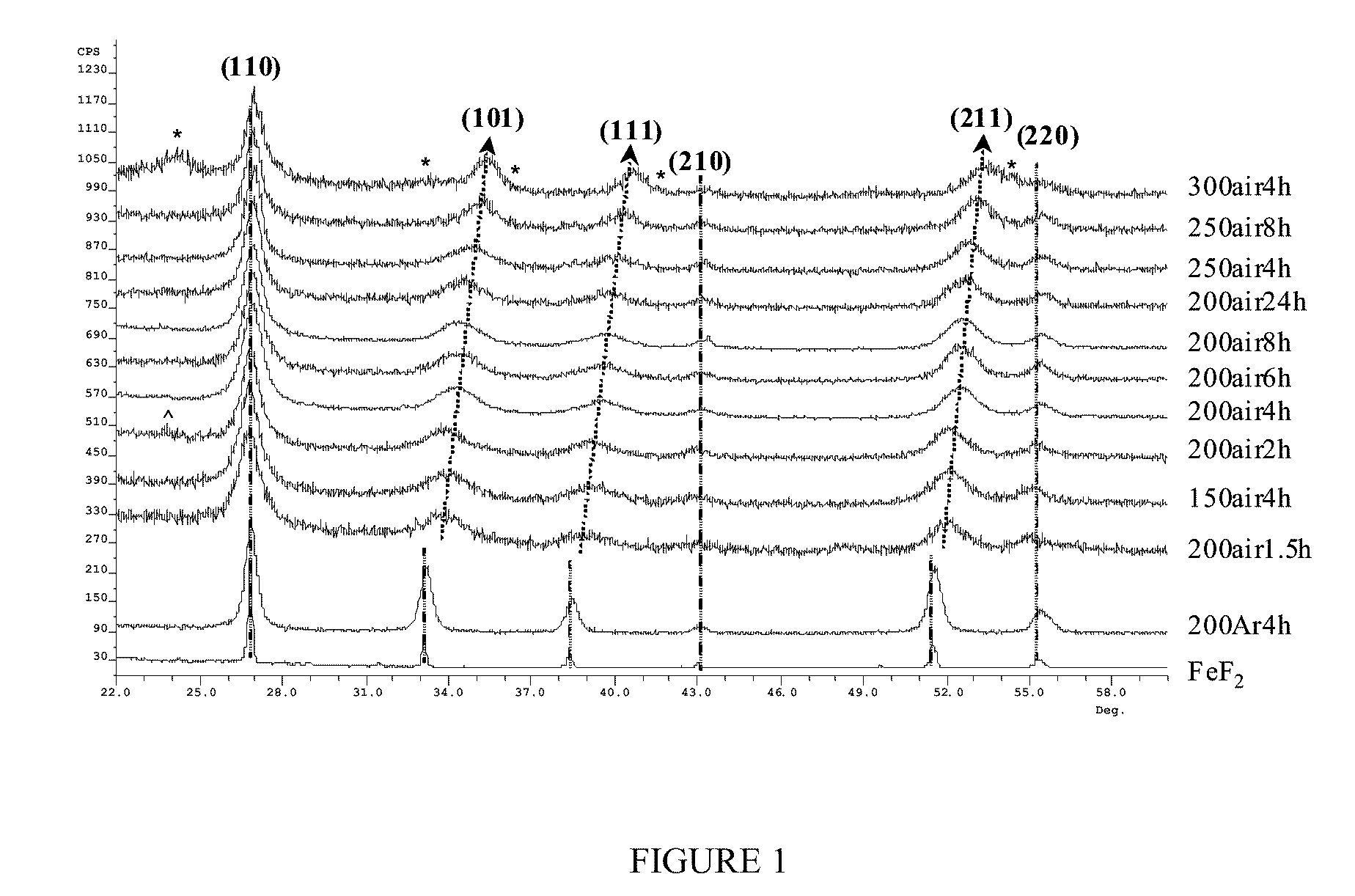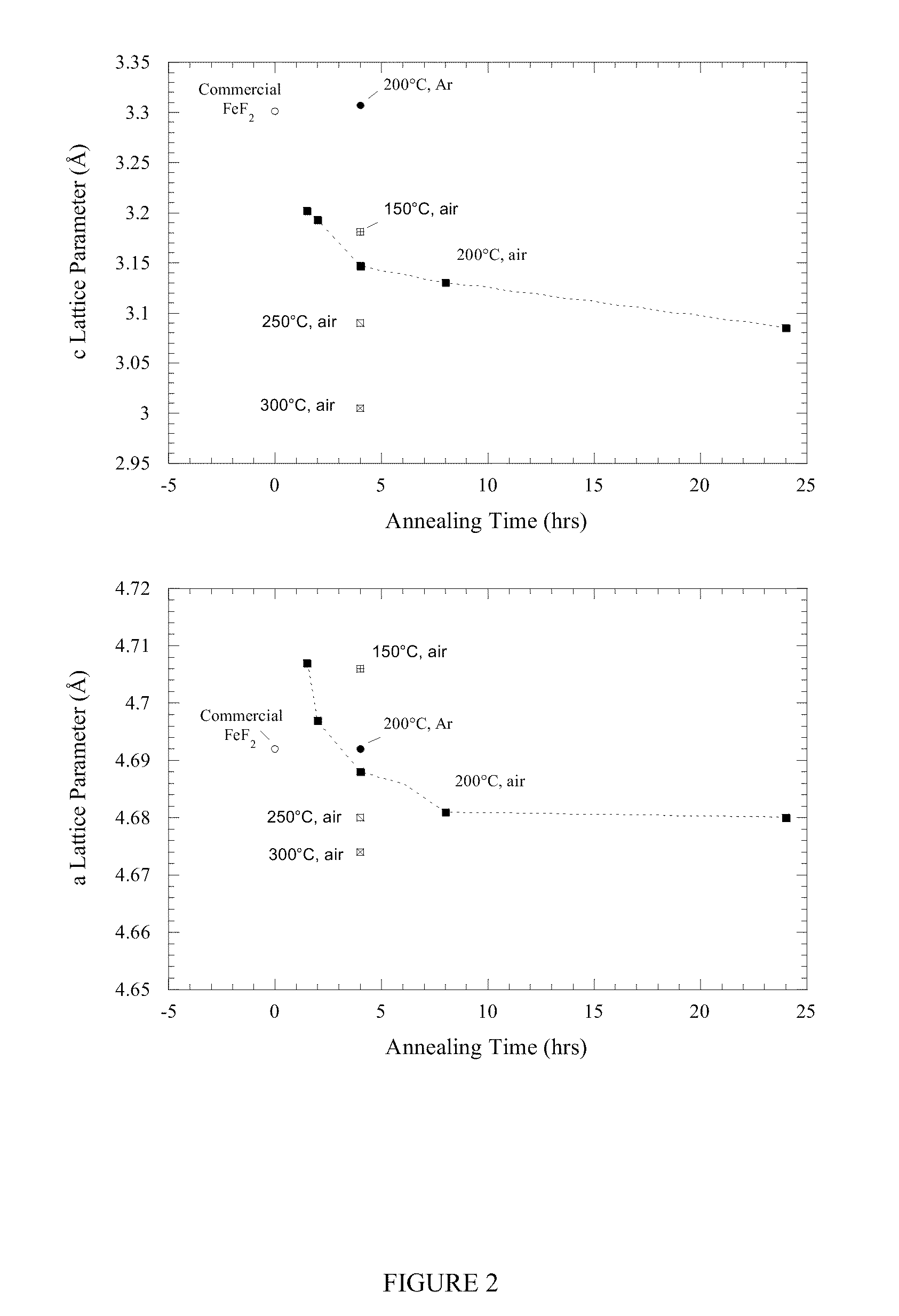Iron Oxyfluoride Electrodes for Electrochemical Energy Storage
a technology of iron oxyfluoride and electrochemical energy storage, which is applied in the direction of iron halides, non-metal conductors, cell components, etc., can solve the problems of large crystallographic distortion range, limiting the realization of such energy density increase, and little to prevent shearing
- Summary
- Abstract
- Description
- Claims
- Application Information
AI Technical Summary
Benefits of technology
Problems solved by technology
Method used
Image
Examples
example 1.1
Solution Fabrication Process Methodology
[0105]Nanostructured iron (oxy)fluoride materials of tunable oxygen content were fabricated through a solution fabrication process from iron metal and fluorosilicic acid (H2SiF6) aqueous solutions. Briefly, iron metal (10 grams) in powder form was dissolved in 141 grams of a 20-25 wt % fluorosilicic acid in water solution. The mixture was placed at 40-45° C. overnight to allow the reaction of the metal with the fluorosilicic acid. After filtering the excess iron metal, the resulting green solution was placed in air at 110° C. until a dry powder formed. An alternative route consisted in drying the solution for 2-3 hours at 200° C. (e.g., on a stirring hotplate) prior to drying at 110° C. The latter process reduced the processing time considerably. Both routes resulted in the synthesis of a FeSiF6 hydrate compound in the powder form.
[0106]FIG. 30 shows an illustrative x-ray diffraction (XRD) pattern for the rhombohedral R-3m FeSiF6.6H2O compound...
example 1.2
Effect of Annealing Temperature, Time and Atmosphere on the Iron (Oxy)Fluoride Composition: X-Ray Diffraction
[0109]The solution fabrication process described herein was utilized to synthesize FeF2 compound. This FeF2 compound was distinct from commercially obtained FeF2. When synthesized under argon (Ar), the synthesized FeF2 compound showed no evidence of any second phase while the FeF2 obtained from the commercial source contained small amounts of a Fe2F5.2H2O hydrate. Further, the broader diffraction peaks associated with the compound obtained by the solution fabrication process indicates that crystallite size (22 nm) of the newly fabricated material was one order of magnitude smaller than the commercial source (>100 nm) (FIG. 1). The crystallite size was determined with the Scherrer formula using the (110) diffraction peaks.
[0110]Upon annealing in air at temperatures as low as 150° C., the FeSiF6 hydrate converts into a rutile-type tetragonal material of P42 / mnm space group simi...
example 2
Carbon-Iron (oxy)fluoride Nanocomposites
Example 2.1
Synthesis of Carbon-FeF2 Nanocomposites
[0112]Carbon-iron fluoride nanocomposites were fabricated by mechanical milling of activated carbon with (i) solution fabrication process derived FeF2, or (ii) commercial FeF2. The milling vessel was loaded and sealed either in a helium (He)-filled glove box or in a dry room with 2 / mnm system symmetry as demonstrated by XRD, shown in FIG. 4. However, milling induced a slight change in the lattice parameters correlated to the splitting of the (220) and (002) Bragg peaks in the 55° 2θ region. This phenomenon was more pronounced with the solution fabrication process derived FeF2, where the splitting stems from a small increase of the a-lattice parameter, which is concomitant with a small decrease of the c-lattice parameter (Table 2).
TABLE 2Unita latticec latticeCrystalliteBETCell Vol.parameterparameterSizeS.A.Samples(Å3)(Å)(Å)(nm)(m2 / g)Commercial FeF272.614.690 ± .0023.300 ± .004>1001.4Solution-ba...
PUM
| Property | Measurement | Unit |
|---|---|---|
| domain size | aaaaa | aaaaa |
| temperature | aaaaa | aaaaa |
| temperature | aaaaa | aaaaa |
Abstract
Description
Claims
Application Information
 Login to View More
Login to View More - R&D
- Intellectual Property
- Life Sciences
- Materials
- Tech Scout
- Unparalleled Data Quality
- Higher Quality Content
- 60% Fewer Hallucinations
Browse by: Latest US Patents, China's latest patents, Technical Efficacy Thesaurus, Application Domain, Technology Topic, Popular Technical Reports.
© 2025 PatSnap. All rights reserved.Legal|Privacy policy|Modern Slavery Act Transparency Statement|Sitemap|About US| Contact US: help@patsnap.com



